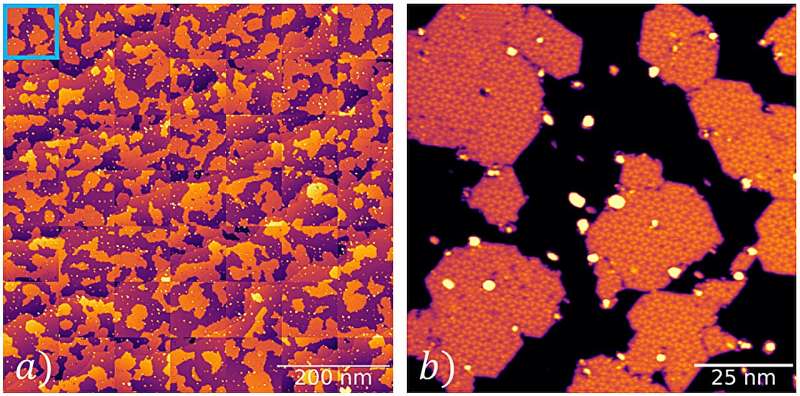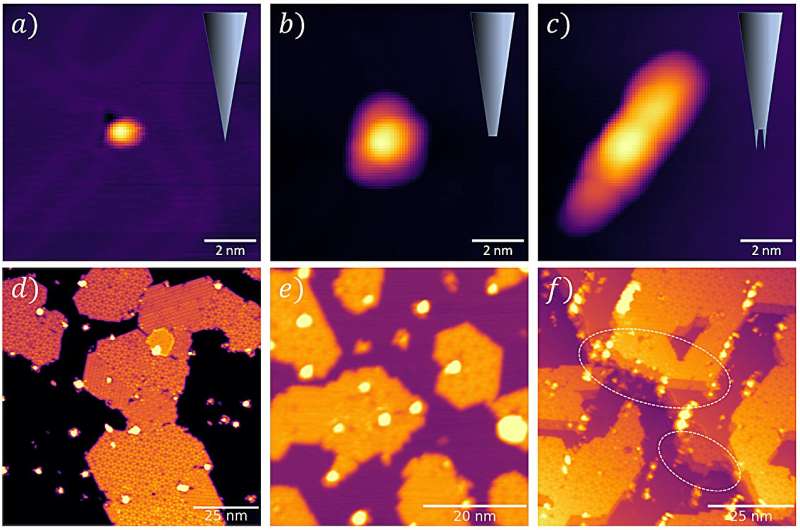This article has been reviewed according to Science X's editorial process and policies. Editors have highlighted the following attributes while ensuring the content's credibility:
fact-checked
proofread
Open-source software helps streamline 2D materials research with scanning tunneling microscope automation

A new open-source software package developed by Monash University researcher Julian Ceddia aims to significantly streamline the study of materials using scanning tunneling microscopes (STMs).
The software, named Scanbot, automates the time-consuming probe optimization and data acquisition processes essential for STM experiments, helping to accelerate 2D materials research by enabling detailed investigation after the STM tip has been automatically optimized and sharpened.
"We hope that Scanbot will benefit STM labs around the world and represent a meaningful step towards full automation of STM experiments," says A/Prof Agustin Schiffrin, also at Monash.
Transforming materials research with STM automation
Exploring and characterizing the atomic landscape of surfaces has become a fundamental pursuit in modern science. STMs are among the most powerful tools that let scientists probe and interact with the world at this unimaginable scale, providing images and spectroscopic data that enable us to peer into the quantum realm and see how materials behave at the atomic level.
STMs work by scanning a probe, sharpened down to a single atom, across the surface of a material while monitoring an electric current. This current carries all the information necessary to build up atomic-scale images of the surface.
However, achieving these breath-taking images is no easy feat. A probe sharpened to the size of a single atom is extremely fragile, and even the slightest contact with another atom, molecule, or debris can drastically alter the probe's effectiveness, requiring researchers to spend considerable time optimizing the instrument to ensure it captures high-quality, reliable data.

Introducing Scanbot
Researchers at Monash University, led by Julian Ceddia, have developed a reliable way to automate this STM optimization process, resulting in the creation of Scanbot—a freely available open-source software package.
The research paper is published in the Journal of Open Source Software.
Ceddia explains that a revelation came to him after getting tired of the hours he routinely wasted optimizing and sharpening the STM tip just to get meaningful data. "After countless hours spent fine-tuning the STM during my Ph.D., I discovered that the quality of the probe could be easily quantified by imaging imprints that it leaves behind after being poked just a few angstroms into the surface."
These imprints carry information about the arrangement of atoms at the tip of the scanning probe and are key to predicting how good the data will be before acquiring it. "Basically, sharper tips leave behind smaller imprints. So, Scanbot automates the process by repeatedly pressing the tip into the surface until the imprint shows that the tip is sharp enough for high-quality imaging," Ceddia explains.
This straightforward approach to "tip shaping" avoids many of the challenges associated with using machine learning for similar tasks. "Instead of training an AI on vast amounts of labeled data to recognize high-quality images, Scanbot uses simple algorithms to measure the size and symmetry of the probe apex based on the imprints it leaves," adds Dr. Benjamin Lowe, a key collaborator on the project.
But Scanbot's capabilities extend beyond just tip shaping. It also automates common data acquisition techniques, such as sample surveying, making STMs easier to operate overall. "My goal with Scanbot was to make STM more accessible and user-friendly," says Ceddia. "That's why I invested a lot of time into designing an intuitive user interface and writing comprehensive documentation."
Industry recognition and impact
Scanbot's potential was aptly captured by former Monash University researcher Jack Hellerstedt, who also made significant contributions to the project, "Scanbot has the heretical potential to get-up-and coming surface scientists thinking about the data instead of clicking the button."
The industry is already taking notice of Scanbot's capabilities. SPECS, a leading company in STM system control, recently contacted Ceddia after discovering Scanbot.
"Receiving an email from SPECS asking to include links to Scanbot in their documentation was incredibly encouraging," Ceddia reflects. "It's a strong validation that our work could genuinely make a difference in the way STMs are operated."
More information: Julian Ceddia et al, Scanbot: An STM Automation Bot, Journal of Open Source Software (2024). DOI: 10.21105/joss.06028
Provided by FLEET




















